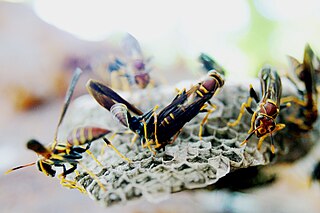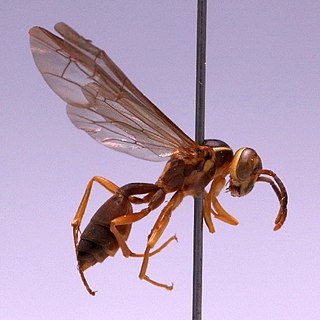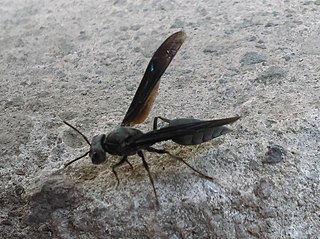
Polistes annularis is a species of paper wasp found throughout the eastern half of the United States. This species of red paper wasp is known for its large size and its red-and-black coloration and is variably referred to as a ringed paper wasp or jack Spaniard wasp. It builds its nest under overhangs near bodies of water that minimize the amount of sunlight penetration. It clusters its nests together in large aggregations, and consumes nectar and other insects. Its principal predator is the ant, although birds are also known to prey on it. Unlike other wasps, P. annularis is relatively robust in winter conditions, and has also been observed to store honey in advance of hibernation. This species has also been used as a model species to demonstrate the ability to use microsatellite markers in maternity assignment of social insects.

Polistes exclamans, the Guinea paper wasp, is a social wasp and is part of the family Vespidae of the order Hymenoptera. It is found throughout the United States, Mexico, the Bahamas, Jamaica and parts of Canada. Due to solitary nest founding by queens, P. exclamans has extended its range in the past few decades and now covers the eastern half of the United States, as well as part of the north. This expansion is typically attributed to changing global climate and temperatures. P. exclamans has three specific castes, including males, workers, and queens, but the dominance hierarchy is further distinguished by age. The older the wasp is, the higher it is in ranking within the colony. In most P. exclamans nests, there is one queen who lays all the eggs in the colony. The physiological similarities between the worker and queen castes have led to experiments attempting to distinguish the characteristics of these two castes and how they are determined, though males have easily identifiable physiological characteristics. Since P. exclamans live in relatively small, open combed nests, they are often subject to predators and parasites, such as Chalcoela iphitalis, Elasmus polistis, and birds. P. exclamans have defense and recognition strategies that help protect against these predators and parasites.

The Central American paper wasp is a nocturnal eusocial wasp. It is famous for its swarm based emigration behavior, and is native to the lowlands of Central and northern South America. This species has developed special night vision adaptations to facilitate their night-time swarming and foraging behavior and has important medicinal properties for the Pankararú people of Brazil.

Polistes instabilis, or Unstable paper wasp is a type of paper wasp, is a neotropical, eusocial wasp that can be found in tropical and subtropical areas such as Central America and South America. It can be easily identified with its characteristic yellow, brown, and reddish markings, and it builds nests made from chewing plant fibers and making them into paper.

Polybia occidentalis, commonly known as camoati, is a swarm-founding advanced eusocial wasp. Swarm-founding means that a swarm of these wasps find a nesting site and build the nest together. This species can be found in Central and South America. P. occidentalis preys on nectar, insects, and carbohydrate sources, while birds and ants prey on and parasitize them. P. occidentalis workers bite each other to communicate the time to start working.

Polistes bellicosus is a social paper wasp from the order Hymenoptera typically found within Texas, namely the Houston area. Like other paper wasps, Polistes bellicosus build nests by manipulating exposed fibers into paper to create cells. P. bellicosus often rebuild their nests at least once per colony season due to predation.

Angiopolybia pallens is a species of social wasp predominantly found in South America. The wasp is generally seen in Brazilian rainforests. This species was discovered by Lepeletier in 1836. It typically feeds on nectar and carrion. In fact much of its feeding behavior and impact on humans is centered on feeding on animal carcasses. The wasp species displays a caste differentiation that can be seen by difference in ovarian development. Additionally they have a unique colony establishment procedure. It begins with a few individuals from the nest leaving to find a good site and then the rest of the colony follows using specific communication signals that are further discussed in this article.

Agelaia pallipes is a species of social paper wasp found from Costa Rica to Brazil, Argentina and Paraguay. A. pallipes is ground-nesting and is one of the most aggressive wasps in South America. This species is a predator of other insects, including flies, moths, and ground crickets, as well as baby birds.

Protonectarina sylveirae, commonly referred to as the Brazilian wasp, is a neotropical swarm-founding wasp species that ranges widely across South America. This species relies heavily on the consumption of animal protein rather than nectar. P. sylveirae preys heavily on agricultural pests to coffee crops, keeping pest populations low.

Belonogaster petiolata is a species of primitively eusocial wasp that dwells in southern Africa, in temperate or subhumid climate zones. This wasp species has a strong presence in South Africa and has also been seen in northern Johannesburg. Many colonies can be found in caves. The Sterkfontein Caves in South Africa, for example, contain large populations of B. petiolata.
The African swarm-founding wasp, Polybioides tabidus, is a social paper wasp from the order Hymenoptera that is typically found in Central Africa. This wasp is unique in that it exhibits cyclical oligogyny, meaning queen number varies with colony cycle. After several generations of production of workers and future queens, a subset of many workers and queens leave the original colony to begin a new one. The new colony does not produce new queens until current queens from the old colony have died. P. tabidus has been observed to display both predator and scavenger behavior, depending on the food sources available.
Protopolybia exigua is a species of vespid wasp found in South America and Southern Brazil. These neotropical wasps, of the tribe Epiponini, form large colonies with multiple queens per colony. P. exigua are small wasps that find nourishment from nectar and prey on arthropods. Their nests are disc-shaped and hang from the undersides of leaves and tree branches. This particular species of wasp can be hard to study because they frequently abandon their nests. P. exigua continuously seek refuge from phorid fly attacks and thus often flee infested nests to build new ones. The wasps' most common predators are ants and the parasitoid phorid flies from the Phoridae family.

Polybia sericea is a social, tropical wasp of the family Vespidae that can be found in South America. It founds its colonies by swarming migrations, and feeds on nectar and arthropods.

Polybia rejecta is a species of social wasp found in the Neotropics region of the world. It was discovered by Fabricius in South America in the 1790s. The wasp is associated with many other organisms, particularly specific species of ants and birds such as the Azteca ants and the cacique birds. This association is most beneficial to the ants and birds because of the aggressive protective nature of the wasp. The wasps will protect their nest even if it means death against any predator that approaches it and therefore this means that the association also protects the ants and birds. Additionally, the wasp is known for eating the eggs of red eyed tree frogs as a main way of subsistence. It also, like many other wasp species, has a caste system of queens and workers that is evident by difference in body size among the wasps; the biggest female becomes the queen.

Ropalidia romandi, also known as the yellow brown paper wasp or the yellow paper wasp. is a species of paper wasp found in Northern and Eastern Australia. R. romandi is a swarm-founding wasp, and manages perennial nests. Its nests are known as 'paper bag nests' and have different architectural structures, depending on the substrates from which they are built. The specific name honors Gustave, baron de Romand, a prominent French political figure and amateur entomologist.

Synoeca surinama is a Neotropical swarm-founding wasp of the tribe Epiponini. It is known for its metallic blue and black appearance and painful sting. S. surinama builds nests on tree trunks and can be found in tropical climates of South America. When preparing to swarm, there are a number of pre-swarming behaviors that members of S. surinama colonies partake in, such as buzzing runs and occasional brood cannibalism. In S. surinama, social environmental conditions determine the caste ranks of individuals in the developing brood. Unlike less primitive Hymenoptera species, S. surinama display little morphological variation between egg laying queens and workers. S. surinama wasps visit flowering plants and are considered pollinators. When these wasps sting, the stinger is left in the victim and the wasp ultimately dies.

Synoeca septentrionalis is one of five species of wasps in the genus Synoeca. It is a swarm-founding wasp that is also eusocial, exhibiting complicated nest structure and defense mechanisms and a colony cycle including a pre-emergence phase and a post-emergence phase. It is typically found in areas from Central to South America. This wasp is one of the larger species of paper wasps and exhibits multiple morphological adaptations as a result of this. Synoeca septentrionalis is known for possessing a very painful sting.

Agelaia multipicta is a swarm-founding, highly eusocial wasp that lives in Mexico, Argentina, Trinidad and southern Brazil. It nests in natural cavities such as hollow trees and aggressively defends the nest from ants, who are brood predators. The workers and queens are morphologically distinguished by ovarian development as well as external features such as a larger petiole and gaster in the queen. Like other carrion-eating (necrophagous) wasp species, A. multipicta plays a scavenging role in the ecosystem. Agelaia multipicta was described by the Irish entomologist Alexander Henry Haliday in 1836.
Parachartergus colobopterus is an epiponine social wasp belonging to the subfamily Polistinae. This species can be found through Central and South America and is unique because its colonies contain multiple queens. However, relatedness among nest mates remains relatively high as a result of cyclical oligogyny, which is a system where the number of queens varies over time. Because workers and queens do not demonstrate any significant morphological differentiation, individuals of this species are totipotent, capable of differentiation into any caste, because caste is not genetically determined. Relatedness and conflict therefore play a major role in determining the dominance hierarchy and behavioral patterns of this wasp species, especially the behavior of worker policing. Another unique characteristic of this wasp is that it is generally a docile species: when the nest is continuously provoked, the colony members will leave the nest instead of mounting an attack.

Polybia paulista is a species of eusocial wasp occurring in Brazil, Paraguay, and Argentina.
















